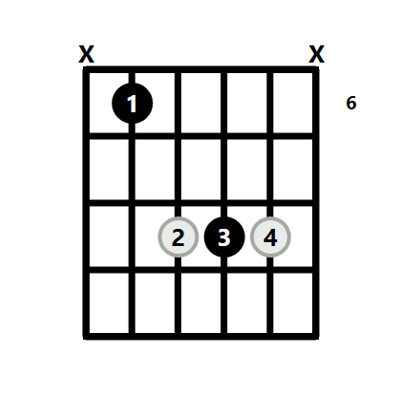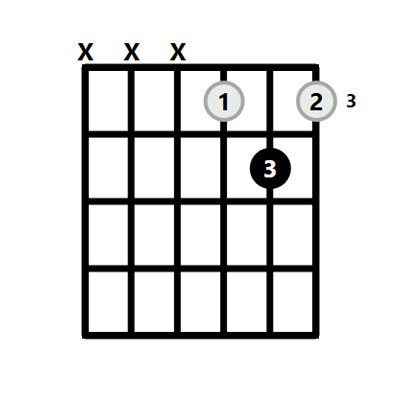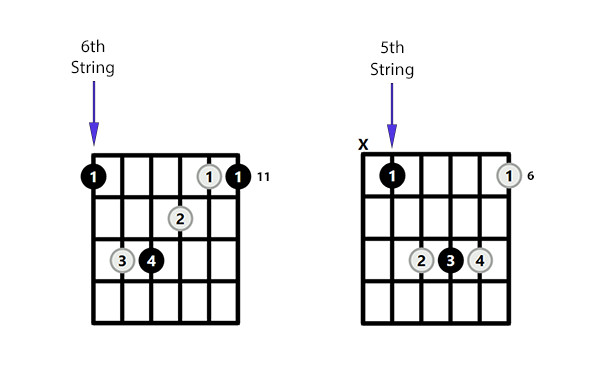The Eb Major chord, often simply called the Eb chord, is a foundational chord for guitarists across genres. From pop and rock to jazz and blues, the rich and versatile sound of the Eb chord resonates in countless songs. Whether you’re just starting your guitar journey or looking to deepen your understanding, mastering the Eb chord is an essential step. This guide will explore various ways to play the Eb chord on guitar, delve into the music theory behind it, and show you how to use it effectively in your playing.
Understanding the Eb Major Chord
To truly master the Eb Chord Guitar, it’s helpful to understand the basic music theory that defines it. Like all major chords, the Eb chord has a bright and uplifting quality, making it a powerful tool in your musical toolkit.
Eb Chord Theory
The Eb Major chord is built upon three fundamental notes:
- Eb (Root): This is the foundational note of the chord, giving it its name.
- G (Major Third): This note, a major third interval above the root, contributes to the major quality of the chord.
- Bb (Perfect Fifth): The perfect fifth interval above the root, this note adds stability and completeness to the chord.
These three notes – Eb, G, and Bb – are derived from the E flat Major scale. Specifically, they are the 1st, 3rd, and 5th notes of the E flat Major scale. Understanding this connection to the scale can further your understanding of how the Eb chord functions musically.
Like all Major chords, the Eb Major chord follows a specific interval pattern starting from its root note:
- Major 3rd: The interval between Eb and G.
- minor 3rd: The interval between G and Bb.
- Perfect 4th: The interval from Bb back to the octave Eb (completing the chord structure).
It’s also important to note that the Eb Major chord holds a significant position in musical keys. It is the tonic chord (I chord) in the key of Eb Major. This means it’s the home chord and the most stable chord within that key. The complete set of chords in the key of E flat Major are: Eb Major, Fm (F minor), Gm (G minor), Ab (Ab Major), Bb (Bb Major), Cm (C minor), and D diminished.
Why Learn the Eb Chord?
The Eb chord is not just another chord to learn; it’s a gateway to broader musical expression on the guitar. Here’s why dedicating time to master the Eb chord guitar is valuable:
- Common Chord in Popular Music: The Eb chord appears frequently across a vast range of musical genres. You’ll find it in pop hits, classic rock anthems, soulful blues progressions, and sophisticated jazz compositions. Knowing the Eb chord unlocks your ability to play a huge catalog of songs.
- Expands Your Chord Vocabulary: Learning the Eb chord, especially in its various forms, expands your overall chord vocabulary. This allows for more creative chord progressions and a richer understanding of harmony.
- Essential for Playing in Specific Keys: If you want to play songs or compose music in keys like Eb Major, Bb Major, Ab Major, or C minor, the Eb chord is indispensable. It serves as a primary chord in these keys, and you’ll encounter it frequently.
Exploring Different Eb Chord Shapes
One of the great things about guitar is the variety of ways you can play the same chord. The Eb chord guitar is no exception. Let’s explore some essential shapes, starting with the most common.
Standard Eb Chord Shape
The most widely recognized way to play the Eb chord on guitar is a root-5 barre chord shape, typically positioned on the 6th fret. While often referred to as a barre chord, in this common Eb shape, the index finger might not always form a complete barre. Instead, it often focuses on pressing down the root note on the 6th fret of the 5th string.
 Eb Chord Guitar
Eb Chord Guitar
How to Play the Standard Eb Chord Shape (Step-by-Step):
- Index Finger: Place your index finger on the 6th fret of the 5th string. Ensure the string is pressed down cleanly just behind the fret.
- Middle Finger: Position your middle finger on the 8th fret of the 4th string.
- Ring Finger: Place your ring finger on the 8th fret of the 3rd string.
- Pinky Finger: Place your pinky finger on the 8th fret of the 2nd string.
- Strumming: Avoid strumming the 6th string (the thickest string). Strum downwards or upwards across the top five strings (5th, 4th, 3rd, 2nd, and 1st strings).
These step-by-step instructions are particularly helpful when learning new chord shapes. If you’re unsure if you’re playing the Eb chord correctly, going through these steps can help you verify your finger placement and ensure you’re producing the intended sound.
Easy Eb Chord Shape
For beginners or when you need a simpler voicing, the easy version of the Eb chord is a fantastic alternative. This shape focuses on the top three strings of the guitar and is less physically demanding than the barre chord version. It’s a great entry point to using the Eb chord in your playing.
Interestingly, this easy Eb shape shares a close relationship with the open D chord shape. It is essentially the same shape as the standard open D chord, but moved up one fret on the guitar neck and without playing the open strings of the D chord shape.
 Easy Eb Chord Guitar
Easy Eb Chord Guitar
How to Play the Easy Eb Chord Shape:
- Index Finger: Place your index finger on the 1st fret of the 3rd string.
- Middle Finger: Place your middle finger on the 3rd fret of the 2nd string.
- Ring Finger: Place your ring finger on the 3rd fret of the 1st string.
- Strumming: Strum only the top three strings (3rd, 2nd, and 1st strings). Avoid strumming the thicker strings.
This simplified Eb chord shape is perfect for situations where you need quick chord changes or are playing songs at a faster tempo.
Barre Chord Shapes for Eb
As you progress, mastering barre chord shapes for the Eb chord will significantly expand your versatility. Barre chords are movable shapes, meaning once you learn the basic form, you can slide it up and down the neck to play different chords. For the Eb chord guitar, two primary barre chord shapes are crucial:
- Root 6 Barre Chord Shape: This shape is based on the E Major barre chord shape, but moved up the fretboard. To play Eb, you would position this shape with your index finger barring across the 11th fret.
- Root 5 Barre Chord Shape: This is the same shape as the standard Eb chord we discussed earlier, based on the A Major barre chord shape and positioned with the root on the 6th fret of the 5th string.
 Eb Barre Chord Guitar
Eb Barre Chord Guitar
Using barre chords for Eb offers several advantages:
- Versatility Across the Neck: Barre chords allow you to play the Eb chord (and other chords) in different positions on the fretboard, offering varied tonal colors.
- Smooth Chord Transitions: Barre chords facilitate quicker and smoother transitions between chords, especially when moving between chords in different positions.
- Strengthened Fretting Hand: Practicing barre chords builds strength and dexterity in your fretting hand.
Eb Major Triads
Beyond full chord shapes, exploring Eb Major triads is another valuable approach. Triads are three-note chords that form the foundation of harmony. Understanding and practicing triads provides a deeper insight into chord construction and can add a different texture to your playing.
The Eb Major triad consists of the same notes as the full Eb Major chord: Eb, G, and Bb. However, triads can be voiced in different inversions, changing which note is the lowest (bass) note. The three inversions of the Eb Major triad are:
- Root Position: Eb – G – Bb (Root note is Eb)
- 1st Inversion: G – Bb – Eb (Third of the chord, G, is in the bass)
- 2nd Inversion: Bb – Eb – G (Fifth of the chord, Bb, is in the bass)
 Eb Major Triad Guitar
Eb Major Triad Guitar
Practicing Eb Major triads in their various inversions can enhance your understanding of chord voicings and give you more melodic and harmonic options when playing or composing.
Alternative Eb Chord Shapes
While the shapes discussed above are the most common, there are always alternative Eb chord shapes that can be useful in specific musical contexts. These might be less frequently used but can offer unique voicings or be easier to play in certain chord progressions. Exploring different shapes enriches your sonic palette and expands your technical abilities.
 Eb Major Chord – 10 Shapes
Eb Major Chord – 10 Shapes
Experimenting with these alternative shapes can lead to interesting discoveries and help you find voicings that perfectly suit your musical style.
Playing Music with the Eb Chord
Understanding the Eb chord guitar is only the first step. To truly utilize it, you need to know where it fits within music and how you can use it creatively.
Keys Featuring the Eb Chord
The Eb chord naturally appears in several musical keys. Knowing these keys helps you understand the harmonic role of the Eb chord and how it interacts with other chords in a song. The keys that prominently feature the Eb chord are:
- Eb Major: As mentioned earlier, Eb is the tonic (I) chord in the key of Eb Major.
- Bb Major: Eb is the IV chord in the key of Bb Major (Bb – Cm – Dm – Eb – F – Gm – Adim).
- Ab Major: Eb is the V chord in the key of Ab Major (Ab – Bbm – Cm – Db – Eb – Fm – Gdim).
- C minor: Eb is the III chord in the key of C minor (Cm – Ddim – Eb – Fm – Gm – Ab – Bb).
- G minor: Eb is the VI chord in the key of G minor (Gm – Adim – Bb – Cm – Dm – Eb – F).
- F minor: Eb is the VII chord in the key of F minor (Fm – Gdim – Ab – Bbm – Cm – Db – Eb).
Being aware of these key relationships allows you to anticipate where the Eb chord might appear in songs and helps you when writing your own music.
Chord Substitutions for Eb
In certain situations, you can use chord substitutions to add harmonic variation and interest. The Eb chord guitar can often be effectively substituted with related chords that share a similar function or root note. Common substitutions for the Eb chord include:
- Eb sus4: Adds a suspended and slightly unresolved quality.
- Eb sus2: Creates a brighter, more open sound.
- Eb add9: Adds a jazzy, extended harmonic color.
Conversely, the Eb chord itself can sometimes act as a simplification or substitution for more complex chords that have Eb as the root, such as:
- Eb Major 7: A richer, more sophisticated major chord.
- Eb7: A dominant 7th chord with a bluesy, driving feel.
- Eb minor chords: Eb cannot substitute minor chords, as the harmonic function is different.
Understanding chord substitutions expands your creative options and allows you to add depth and nuance to your guitar playing.
Scales for Soloing Over Eb
When soloing or improvising over an Eb chord progression, selecting appropriate scales is crucial for creating melodies that sound harmonically consonant and musically engaging. Effective scales to use over the Eb Major chord include:
- Eb Major Scale: The most fundamental choice, perfectly outlining the Eb Major tonality.
- Eb Mixolydian Mode: A major scale with a flattened 7th, giving a bluesy or dominant feel.
- Eb Lydian Mode: A major scale with a raised 4th, creating a brighter, more ethereal sound.
Experimenting with these scales and understanding how their notes relate to the Eb chord tones will unlock your improvisational potential.
Conclusion
The Eb chord guitar is a vital chord to master for any guitarist. From its theoretical underpinnings to its various shapes and musical applications, a thorough understanding of the Eb chord will significantly enhance your playing and musical knowledge. By practicing the different shapes, exploring its role in various keys, and experimenting with substitutions and scales, you’ll unlock the full potential of the Eb chord and enrich your guitar playing journey. So, pick up your guitar, explore these Eb chord shapes, and start incorporating this essential chord into your musical repertoire today!
Further Reading
[
